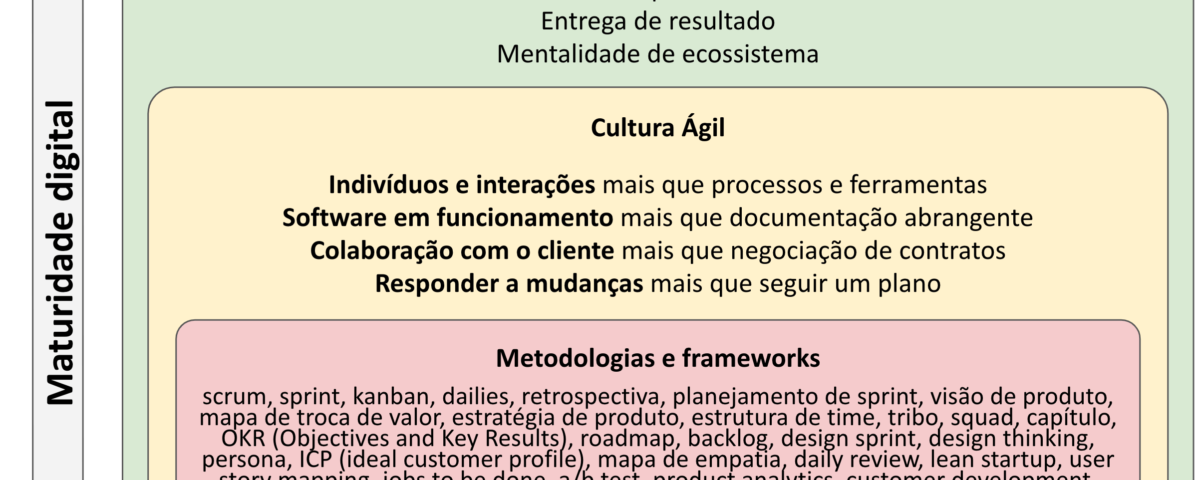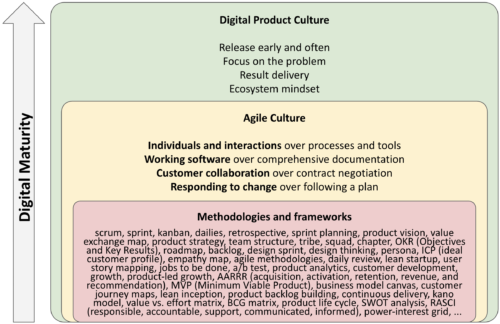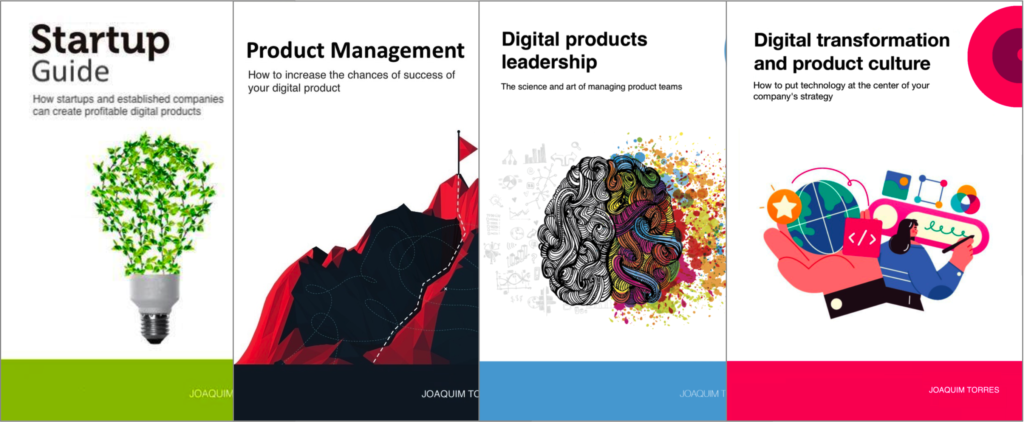
Business models
12 de March, 2024
Fasten your seat belts, we are at a turning point! Again!
26 de March, 2024To increase the chances of success in a digital transformation, it is essential to create and foster a digital culture, also known as a product culture.
The word “culture” comes from the Latin word “culere,” which means “to cultivate.” Edgar Schein, a professor at the MIT Sloan School of Management, was one of the first people to discuss organizational culture in the 1970s. According to him, each company has its own personality and its unique way of acting and reacting to situations. This way of behaving is passed down from employee to employee, starting from the company’s founders.
Organizational Culture
Culture is a set of assumptions that have been learned and shared by a group of people as they solved external adaptation and internal integration problems. This set of assumptions works well enough to be considered valid and, consequently, is taught to new members of the group as the correct way to perceive, think, and feel about these problems.“
Edgard Schien
Explaining in an even more concise way, culture is nothing more than the set of principles and behaviors that a group of people uses in their daily lives. Culture comes from the founders of the company. Founders have their own culture, and it is natural for them to imprint it on the organization they are creating. Because of this, it is very common to think that it is something that emerges in an organization. Schein warns that this is a mistake. Cultures can and should be planned, and it is our role and responsibility to plan and promote the company’s culture.
Agile culture
The agile culture is a set of principles and behaviors developed to help improve the software development process. It was created in 2001 by 17 software developers with the following statement:
AGILE MANIFESTO
We are uncovering better ways of developing software by doing it and helping others do it. Through this work, we have come to value:
Individuals and interactions over processes and tools
Working software over comprehensive documentation
Customer collaboration over contract negotiation
Responding to change over following a plan
That is, while there is value in the items on the right, we value the items on the left more.
Fonte: Manifesto para Desenvolvimento Ágil de Software
Note that the Agile Manifesto says nothing about agile methodologies or terms like Scrum, sprint, Kanban, dailies, retrospective, sprint planning, etc. It refers to principles and behaviors. It’s common to find companies claiming they are undergoing digital transformation because they’ve implemented some agile methodology, conduct two-week sprints, have teams doing dailies, and use many other ceremonies and terms from agile methodologies. It’s a good start, but implementing an agile methodology without understanding the agile culture and its principles is unlikely to enable the company to make the most of using technology to enhance the business.
Is having an agile culture enough?
It’s clear that just using agile methodologies is not enough. It’s necessary to have and cultivate an agile culture, practicing its principles consistently. The next question that arises is: is having an agile culture sufficient for the success of digital transformation?
The short answer is “no.” The agile culture is a crucial step toward delivering better digital products, but it’s not sufficient. Note that in the Agile Manifesto, it is stated that “we are uncovering better ways of developing software.” I emphasized the words “better ways” because they clearly show the purpose of the agile culture and its principles to improve the software development process.
Let’s make a slight modification to that sentence to illustrate what is not covered by the Agile Manifesto. Imagine that instead of “uncovering better ways of developing software,” the sentence was “uncovering ways to develop better software.” In this sentence, I intentionally shifted the focus to developing and delivering better software, i.e., software that helps achieve the goals of the company that owns the software while solving problems and meeting the needs of its customers.
Agile culture is crucial for digital transformation, but it’s not enough. Something more is needed!
Digital culture or product culture
Just as in the agile world, there are various methodologies and frameworks, it’s common to hear comments from people who are getting to know the area of management and development of digital products, and even from those who have been in the field for some years, that this area is full of frameworks, a word that can be freely translated into “tools.”
Product vision, value exchange map, product strategy, team structure, tribe, squad, chapter, OKR (Objectives and Key Results), roadmap, backlog, design sprint, Scrum, sprint, retrospective, design thinking, persona, ICP (Ideal Customer Profile), empathy map, agile methodologies, Kanban, daily review, lean startup, user story mapping, jobs to be done, A/B testing, product analytics, customer development, growth, product-led growth, AARRR (acquisition, activation, retention, revenue, and referral), MVP (Minimum Viable Product), business model canvas, customer journey maps, lean inception, product backlog building, continuous delivery, Kano model, value vs. effort matrix, BCG matrix, product life cycle, SWOT analysis, RASCI (responsible, accountable, support, communicated, informed), power-interest matrix, and so on.
It’s no wonder people get overwhelmed. The number of tools and frameworks is enormous.
It’s important to be familiar with these tools and know how to use them. Some are used more frequently, others less, but they are only useful when used for the appropriate situations and problems. Making an analogy with physical tools, even to tighten a screw, there are different types of tools such as a flathead screwdriver, Phillips screwdriver, and Allen wrench, which are suitable for different types of screws. You won’t make much progress if you use a Phillips screwdriver on a screw that requires an Allen wrench.
Principles come first!
Before getting to know the tools, it is essential to understand the principles that guide the development and management of products in successful companies like Google, Amazon, Netflix, and Apple, as these principles justify the use of one tool over another.
A principle is a proposition or value that is a guide to a behavior or an evaluation. (Source: Wikipédia)
A principle is something that guides the behavior we should have when dealing with a situation. These are the principles that make up a culture.
When a company decides to embark on a digital transformation, adopting digital technologies to enhance the business, it is not enough to understand the new technologies that will be used. It is also necessary to adopt new principles and behaviors to extract the most value from these new technologies. A digital culture, also known as product culture, must be embraced.
There is a set of four principles that form the core of every successful digital product development team. These principles constitute the digital product culture, which is the set of behaviors used by teams developing digital products that yield the best results. The four principles, which will be the subject of the next part of this book, are:
- Deliver early and often
- Focus on the problem
- Deliver results
- Ecosystem mindset
Putting it all together
To help understand how methodologies, frameworks, digital culture and product culture are related, I created an image that seeks to make this more tangible relationship.
Methodologies, frameworks, agility and product culture.
The arrow represents the path I see companies taking when undergoing digital transformation. First, they implement a bunch of tools and methodologies; then, they realize that these are not enough. They understand the need for agile culture, which significantly improves the digital maturity of the company as it starts to comprehend the principles behind the tools and methodologies. However, it’s still not sufficient, and that’s where product culture comes in, reinforcing the connection between what is being done (digital products), the company’s objectives, and customer problems.
The arrow indicates that this is the most common path companies follow, but it’s not necessarily the most advisable. The preferable approach is to understand that all three aspects (tools and methodologies + agile culture + product culture) are necessary for success in digital transformation, and we should work on all three simultaneously.
There are already good books and courses on tools, methodologies, and agile culture. Therefore, in the next part of the book, I will focus on product culture and the principles that form the foundation for the success of a digital transformation!
Recommendation
I’ve encountered several companies that were using agile methodologies and considered that they had undergone digital transformation. Be cautious! Agile methodologies are just the processes behind the agile culture. Simply following some agile methodology will not help you create better products that assist your company in achieving its goals while solving problems and meeting the needs of your customers. A behavioral change is needed; a cultural shift is required.
And it’s not enough to have an agile culture. It is necessary to go further and have a digital product culture, which is what will help you and your company build better digital products, achieve your strategic objectives, and address the problems and needs of your customers.
Summing up
- Culture is the set of principles and behaviors that a group of people use in their daily lives.
- Agile methodologies are processes, and agile culture involves the behavioral changes necessary to improve these software development processes.
- Agile culture is necessary but not sufficient for the success of digital transformation. The adoption of a digital product culture is required, which involves the constant application of four principles: fast and frequent deliveries, focus on the problem, delivery of results, and an ecosystem mindset.
Digital transformation and product culture
This article is another excerpt from my newest book “Digital transformation and product culture: How to put technology at the center of your company’s strategy“, which I will also make available here on the blog. So far, I have already published here:
- About the book
- Part 1: Concepts
- Chapter 1: The so-called digital transformation – Project and Product
- Chapter 2: Uncertainty and digital transformation
- Chapter 3: Types of company
- Chapter 4: Type of company vs digital maturity
- Chapter 5: Business models
Workshops, coaching, and advisory services
I’ve been helping companies and their leaders (CPOs, heads of product, CTOs, CEOs, tech founders, and heads of digital transformation) bridge the gap between business and technology through workshops, coaching, and advisory services on product management and digital transformation.
Digital Product Management Books
Do you work with digital products? Do you want to know more about managing a digital product to increase its chances of success, solve its user’s problems, and achieve the company objectives? Check out my Digital Product Management books, where I share what I learned during my 30+ years of experience in creating and managing digital products:
- Digital transformation and product culture: How to put technology at the center of your company’s strategy
- Leading Product Development: The art and science of managing product teams
- Product Management: How to increase the chances of success of your digital product
- Startup Guide: How startups and established companies can create profitable digital products



